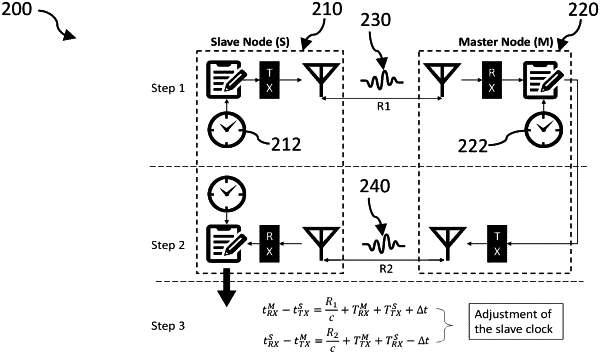| CPC H04W 56/0015 (2013.01) [B64C 39/024 (2013.01); H04B 7/026 (2013.01)] | 20 Claims |

|
1. A system, comprising:
at least one slave node each comprising an unmanned aerial system (UAS); and
one master node, comprising one UAS,
wherein the at least one slave node and the one master node are configured to execute instructions for a method of enhanced multi-way time transfer for time synchronization between the at least one slave node and the master node, the method comprising:
sending, by one slave node of the at least one slave node, a first message to the master node to launch a time synchronization between the slave node and the master node, the first message including a start time of sending the first message on a slave clock of the slave node, and the slave node calculating a Transmit (TX) processing time of the first message;
upon receiving the first message, adding, by the master node, a receiving time of receiving the first message on a master clock of the master node to the first message to form a second message, the master node calculating a Receive (RX) processing time of the first message;
sending, by the master node, the second message back to the slave node, the second message including a start time of sending the second message on the master clock of the master node, and the master node calculating a TX processing time of the second message;
adding, by the slave node, a receiving time of receiving the second message on the slave clock of the slave node to the second message to form an updated message, the slave node calculating a RX processing time of the second message; and
performing, by the slave node, a time adjustment to the slave clock of the slave node based on the updated message, thereby synchronizing time between the slave clock of the slave node and the master clock of the master node, wherein:
the slave node calculates a first distance between the slave node and the master node at the start time of sending the first message, and calculates a second distance between the slave node and the master node at the start time of sending the second message, and
the time adjustment is determined by the slave node based on following elements including: the start time of sending the first message, the TX processing time of the first message, the receiving time of receiving the first message, the RX processing time of the first message, the start time of sending the second message, the TX processing time of the second message, the receiving time of receiving the second message, the RX processing time of the second message, the first distance, and the second distance.
|